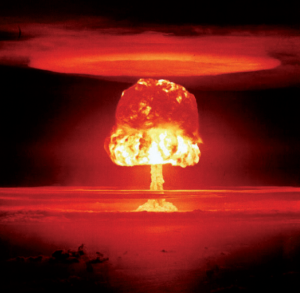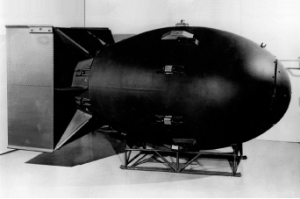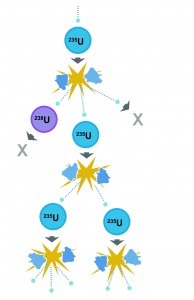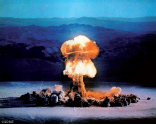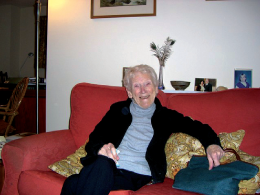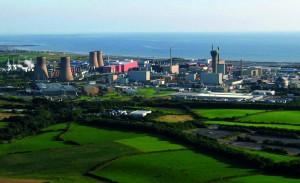THURSDAY, 1 OCTOBER 2009
Hiroshima, a western city on the largest island of Japan, was destroyed by a single bomb, whose core was the size of a baseball. Nagasaki, on one of the smaller islands, followed.The atomic bomb or “Manhattan Project” could be said to have started in Nazi Germany 1939, when German chemist Otto Hahn proved that uranium could be split by a neutron, releasing a significant amount of energy. If that energy could be harnessed in a uranium chain reaction, the power would be staggering. Spurred on by the fear of such a weapon in enemy hands, three scientists working in America: Leo Szilard, Edward Teller and Enrico Fermi, authored a letter to then President Roosevelt. It urged America to accelerate nuclear research with the aim of ensuring that the Allies developed the bomb first. To give their letter the required force, they convinced noted pacifist, Albert Einstein, to put his name to it. He agonised for months over the decision. Later he was a vociferous campaigner against nuclear weapons co-authoring the Russell-Einstein manifesto, whose offspring is the ethical science society Pugwash.
In light of these recommendations, in October 1939 Roosevelt set up an advisory council on uranium, allocating it $6000 for materials. By the end of the war the project had the full weight of government and military funding behind it. The project was enormous. It employed roughly 500,000 people over four main sites: uranium separation at Oak Ridge Tennessee, with electromagnetic separation led by Ernest Lawrence; plutonium processing via a nuclear reactor at Hanford. Arthur Compton was in charge of the initial chain reaction work led by Enrico Fermi at the Metropolitan Laboratory in Chicago. The bomb design and construction team at Los Alamos was led by Robert Oppenheimer.
In order to succeed, they had to overcome significant technological barriers. Firstly, they needed enough fissile material. Natural uranium contains 99% U-238. Since, only the rarer isotope, U-235, is susceptible to the chain reaction, it was important to find a process to separate U-235 from the more abundant U-238. The work at Lawrence’s laboratory exploited the mass difference between the isotopes. A strong magnetic field would deflect the electrically charged uranium by different degrees, depending upon the mass, separating and purifying the U-235. Two other methods of separation were also used: gaseous diffusion and liquid thermal diffusion. The former uses a porous barrier through which the lighter isotope in a gas will pass more easily, whilst the latter is a convection-based process. The engineering of these projects was huge and required considerable skill – the coils required to make the magnets for separation used 14,700 tons of silver. The building constructed to house the gaseous diffusion equipment was the largest in the world at that time. Yet despite this, the town and site remained relatively secret.
Each stage required additional construction and expertise. In order to achieve the first self-sustained chain reaction, Fermi and Szilard designed and built the world’s first nuclear reactor, Chicago Pile-1. They arranged Uranium pellets, graphite blocks to slow down the neutrons and cadmium-based control rods to absorb neutrons released by the uranium and slow down the reaction, in a carefully calculated structure.
In 6 June 1944 the Allies launched the Normandy invasion. Germany surrendered on 7 May 1945 without completing its own atomic bomb project.
The scientists and military were deeply divided about what to do with the completed bomb. The war against Japan was growing fiercer. The longer the war continued the more lives would be risked. This was the weapon to end all wars.
However, some saw the bomb’s purpose as complete. Those at the Chicago Laboratory voiced their opinions in the Jeffries Report of November 1944. Its contents asked that the American people be told about the Manhattan Project, the destructive potential of the bomb and its implications for future international relations. Scientists such as Szilard, integral in making the bomb, were determined that the bomb should never be used. It should remain a deterrent. Szilard collected 67 signatures of eminent scientists in a petition urging the new President Truman not to use the bomb.
The bomb was tested on 16 July 1945 and the surrender of Japan demanded. Japan rejected the Allies’ proposal and on August 6th the first U-235 bomb was dropped, on Hiroshima.
Hiroshima was chosen because it was flat, one of the few Japanese cities not to have been totally devastated by previous US bombing and the headquarters of the Second Japanese Army. This would be a true demonstration of the weapon’s power. However, civilians were by far the greatest victims of the bomb, outnumbering soldiers by six to one. When the bomb was detonated there was an immense burst of light and heat, lasting a fraction of a second, with the temperature at the target point reaching 4000 degrees Celcius. Those within half a mile were incinerated; further out, the heat blistered and tore the skin from people’s bodies. The blast wave travelled the city at two miles per second, destroying everything in its path. Those who survived exhibited painful symptoms including nausea, fever, ulceration and bleeding of the mouth, eyes and lungs symptoms of radiation sickness. For years to come, children showed abnormal growth and radiation-induced disorders.
Three days later, the plutonium bomb ‘Fat Man’ was dropped on Nagasaki. As before, the effect of the bomb was horrific. 70,000 people died in the city that day and more over the ensuing years.
Japan surrendered on August 14th 1945, signalling the end of the Second World War. With its end, the world was confronted with a weapon whose destructive power was unprecedented. Its advocates had hoped that by unleashing its power the world would be terrified into lasting peace. However, the political landscape had changed. In 1943 Klaus Fuchs, the Russian spy within Los Alamos, had already started contacting Soviet agents with details of the bomb. America would not remain the only nuclear-armed superpower for long.
Jennifer Moore is PhD student in the Department of Physics
How Does a Nuclear Bomb Work?
Let’s start at the beginning with an atom. An atom consists of three subatomic particles; protons, neutrons and electrons. Protons and neutrons form the nucleus of the atom while the electrons orbit around them. In nature, atoms of the same element, but with different numbers of neutrons, exist. These are called isotopes. Uranium, which is used to make atomic bombs, has three naturally occurring isoptopes; U-234, U-235 and U-238; where the number indicates the atomic mass.
Isotopes of uranium are radioactive and unstable. They decay to form new elements and in doing so release energy. The half-life of U-235, however, is 704 million years which doesn’t make it the most ideal energy source. So how is uranium used to create such a powerful bomb?
To derive a large amount of energy from uranium in a short period of time, the nucleus can be artificially decayed; split into smaller pieces by bombarding it with neutrons. This process is called induced-fission and effectively mimics the natural decay but on a much shorter time-scale. The neutron is absorbed by the uranium nucleus, increasing its atomic mass by one. The element then becomes more unstable and rapidly decays, splitting into two lighter and faster moving atoms plus two or three singular neutrons. These new neutrons go on to repeat the process causing a chain reaction and a rapid increase in the number of fission reactions taking place.
So how much energy can you get from fission of uranium? Let’s imagine we have one kilogram of uranium (the bomb dropped on Hiroshima had 64 kilograms!). When one atom is split, the energy released is around two trillionths of a Joule. Not much, except that there are approximately 3x1024 atoms in one kilogram of material. The total energy released is about 60 trillion Joules. In comparison, the explosion of one kilogram of TNT releases only four million Joules.
For a sustainable nuclear chain reaction there must be a critical mass of material. To prevent premature fission, the nuclear materials are therefore stored in subcritical mass amounts, which must be bought together for the reaction to take place.
In a gun-triggered nuclear bomb, a gun fires one piece of sub-critical mass into another to form the supercritical mass. This method was used in the ‘Little Boy’ bomb dropped on Hiroshima on 6 August 1945. The explosion was equivalent to 14 million kilograms of TNT.
In an implosion bomb, a shock wave is created, compressing the sub-critical pieces together to form the critical mass. This method was used on ‘Fat Man’ detonated over Nagasaki on 9 August 1945, creating an explosion equivalent to 23 million kilograms of TNT.
As well as the fission nuclear bomb, there are also fusion bombs. Instead of splitting an atom into two, fusion involves binding two nuclei, to form a heavier atom. The process is carried out at high temperatures, giving it the name “thermonuclear bomb”.
The whole process of fusion in the bomb takes about one 600 billionth of a second. The destructive force is many more times that of a fission bomb, typically on the order of a quadrillion kilograms of TNT. The Tsar bomb dropped by the Soviet Union during nuclear testing in the 1960s yielded an explosion a billion times greater than that of Fat Man.
Cheng T. Chong is a PhD stuident in the Department of Engineering
The Mushroom Cloud
Rising thousands of feet high, the mushroom-shaped cloud formed after a nuclear explosion is very distinctive. The bomb detonates just above the ground releasing an immense amount of heat. At the centre of the explosion the temperature can reach several million degrees centrigrade. The result is the sudden formation of a large fireball near to the ground containing hot, low-density gas.
Density differences between the hot air in the fireball and the cold surrounding air cause the fireball to rise. As it rises, air, weapon debris and dust are sucked inwards and upwards, creating a strong updraft and inwardly flowing winds. This forms the distictive mushroom stem. Inside the mushroom head, the hot gas rotates in a doughnut-like shape.
The fireball grows in size but gradually starts to cool down. As the temperature drops, vapour condenses, forming visible clouds. Those clouds contain water droplets, along with debris and nuclear materials. The mushroom head continues to grow in diameter, rising vertically. It stops when the cloud no longer has a lower density than the surrounding air.
The cloud starts out a red or reddish brown colour due to the presence of nitrous acid or nitrogen oxides. As the fireball starts to cool water starts to condense forming droplets, the colour changes, turning white.
Britain and the bomb
How Britain learned to love the bomb but never stopped worrying – an interview with Lorna Arnold, Britain’s official nuclear historian.
“It was the first big nuclear reactor accident in the world. There had been accidents on reactor sites before, but none of them had gone beyond a small area. This one was an accident which could have devastated the whole of north-west England, created a vast fallout and killed a lot of people.”
That is how Lorna Arnold describes the fire that broke out at the military reactor at Windscale, Cumbria in 1957. Later renamed Sellafield, the site still operates today as a nuclear fuel reprocessing plant.
Few people can claim to know as much about the development of British nuclear weapons as 93 year old Lorna Arnold, official historian of the UK Atomic Energy Authority. In the position since the 1960s, and a former Cambridge student, Lorna was among a handful of individuals throughout the Cold War to have access to key atomic scientists and to secrets so sensitive, they were never written down.
After leaving Cambridge, Lorna found herself working in the War Office during the Second World War and then in the British sector of a ravaged Berlin. In 1946 she moved to Washington, where she found herself the only female diplomat and Britain’s first woman in the Foreign Service. From the Pentagon in Washington she coordinated shipments of food and goods that kept Germany from starving. With a modesty that seems anachronistic in today’s society, she puts her extraordinary trajectory down to good luck and all the very nice people she was fortunate to meet.
Here she brings back to life with great passion and energy events long boxed up in dark and dusty recesses of Whitehall archives:
“It was a very tricky time for [Windscale] to happen. The British government had just reached a point where they had arrangements set up for negotiations with the Americans to start a programme. The close wartime and nuclear relationship had been cut off absolutely dead in 1946 by the Americans; they were not going to give information to any other country at all on nuclear matters. So the British, who had been very important in the American nuclear programme and in fact had initiated the whole thing, had been forever trying to get back into the partnership. In 1957 they were in sight of negotiations with the Americans to renew the partnership. They had also just completed a big round of hydrogen bomb tests that established Britain’s credentials as a serious nuclear power.”
Lorna gives short shrift to rumours that Britain never really did develop a genuine hydrogen bomb. “There was a warhead that worked, but it was never engineered for service use because we went into partnership with the Americans and took over an American design. [The bomb] had a British core but an American design.
“Anyway, this was a very tricky point in the negotiations. The Americans might say, ‘Not likely, you’re too incompetent, look at this awful accident [at Windscale], you don’t know what you’re doing.’ They were very afraid that all hopes of the American partnership would be ended.
“At the same time as this was going on, the British government had just announced a national programme of civil nuclear power stations. The plan was to build 12 nuclear power stations over ten years, providing a very considerable proportion of the country’s electricity needs. It was the first civil nuclear programme in the world. “They were so afraid that this accident would set that back and there would be an immediate outcry, ‘We cannot possibly have a civil nuclear power programme because these reactors are so dangerous.’ ”
The reactor that caught fire was not a power reactor at all. The first two reactors built in Cumbria at Windscale, were started in 1946 and built purely to produce plutonium for weapons. The official inquiry that followed, faulted the engineers who were working when the reactor fire broke out. The report was not without consequence for their careers. In her book, ‘Windscale, 1957: Anatomy of a Nuclear Accident’ published in 1995, Lorna set the record straight, in spite of pressure to toe the official line. The inquiry blamed the very people who had in fact averted a terrible disaster by taking huge risks to themselves. The actions of these people were beyond praise, says Lorna.
What about the international context? “It is very difficult to remember now the extraordinary sense of urgency and fear in the early Cold War days. The Americans were more panicky than we were, even though they were geopolitically so secure. They were virtually immune to Russian attack, but we were open to attack, particularly in the very early days after the war, we had nuclear-capable American airfields all over eastern England. The chiefs of staff said that we were now the prime target. If Russia wanted to attack she couldn’t reach America but could reach American airfields in the UK.
So the two reasons that gave the government a sense of urgency to have a nuclear weapons capability, were partly to have a deterrent against Russian attack and also the feeling that we couldn’t rely on the Americans to defend us if the Russians attacked. There was the feeling that the Americans would pay more attention and be more cooperative if we had a nuclear capability. We didn’t want to be treated just like a client state. It was very much thought that the Americans didn’t think much of us, but they were very impressed by the extreme efficiency of the British weapons programme. Though this was not said publicly to be its purpose, I have no doubt at all that it was to have influence and status with the Americans.”
What was the deterrence value of nuclear weapons? “Things are different now; I don’t think anybody would have the nerve now to say it was a deterrent. You can’t make it stand up. If we hadn’t got nuclear weapons and we decided not to develop them, that would be one thing, but being a nuclear power, the third nuclear power in the world, to give them up would be stepping down.
“I’ve spoken to two Russian weapons scientists’ right at the heart of the [Soviet] weapon program. I asked one, German Goncharov, what the Russian view during the Cold War of the British nuclear deterrent was? What effect did it have on Soviet thinking? Did it influence you in any way? He said: ‘I don’t think we ever gave it any thought. It was of no significance, we were interested in your program because it was scientifically very clever. If we could gain anything by espionage that would be one thing, but we weren’t influenced by your British deterrent.’ Then I asked a colleague, a Russian specialist at Stanford University: ‘While you’re in the Moscow nuclear archives, do look through for any reference at all to the British nuclear deterrent and what the Soviet authorities think about it.’ When he came back, he said: ‘Well, I’ve found one reference to the British nuclear deterrent by an old Soviet general who mentioned it very much in passing. Otherwise I found no other reference to it at all.’ Goncharov said to me, ‘Why should we take it seriously? We were concentrating on the Great Satan across the water. Your little deterrent was just an irrelevant appendage to it.’ ”
What about Barack Obama and nuclear disarmament? “I think he will get somewhere but I am not too starry eyed about it because it’s only a question of reducing the stockpiles by so much. They could reduce them by that much and what they’ve got left is still overwhelming. Obviously it’s better than increasing the stockpile; every reduction is very welcome, but nobody could call it disarmament. They will still be left with something like a 1000 warheads each and if you think what a single H-bomb can do – obliterate a whole city and cause long lasting devastation. Only six H-bombs would be enough to wreck this country. I think it will be difficult for Obama. One has to start somewhere. It’s obviously better to start with downsizing than going for what you know you can’t get, which is complete disarmament. I wish him well. [Former American president] Reagan did well on downsizing the stockpiles but both the superpowers have got enormous stockpiles and what good it has done them I am really unsure.”
Tristan Farrow is a PhD student in the Department of Physics
